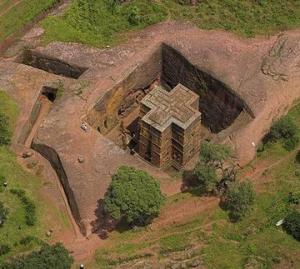
Ethiopia's Biblical Heritage: A Sacred Journey to St. Lalibela’s Ancient Construction
According to his Hagiography, Saint Lalibela, carved the churches over twenty-four years with the command of Lord Jesus Christ and the assistance of angels.
The Bible consistently references Ethiopia, highlighting its profound significance across both the Old and New Testaments. In the Old Testament, numerous passages underscore Ethiopia's presence. Particularly notable are the narratives of King Solomon and the Queen of Sheba (Saba) recounted in 1 Kings 10:1–13 and 2 Chronicles 9:1–12, which signify a longstanding social and religious connection between Israel and Ethiopia. In the New Testament, parallels are drawn: the Queen of Sheba's quest for wisdom from Solomon mirrors the Ethiopian eunuch's pursuit of deeper scriptural understanding under Philip the Deacon in Acts 8:26-40. Moreover, it is worth mentioning that one of the Magi who visited the infant Jesus was Ethiopian. In addition, Moses’ marriage to an Ethiopian woman (Numbers 12:1) ; the affirmation that, "Ethiopia shall hasten to stretch out her hands to God." (Psalm 68:32) are some indications attesting Ethiopians' enduring presence in Biblical narratives and their integral role in the tapestry of religious history.
Texts, from the bible, about the introduction of Christianity to Ethiopia?
The origin of Christianity in Ethiopia dates back to the 1st century A.D, as mentioned in Acts of the Apostles (chap. 8:26-40), when the spirit of God instructed Apostle Philip to go to Gaza and meet the Ethiopian eunuch, who was subsequently baptized by Philip. This event marked the introduction of Christianity to Ethiopia. The Ethiopian Orthodox Tewahedo Church, the oldest Apostolic and historical church in Ethiopia, boasts an extensive organizational structure with 50 dioceses and thousands of priests, deacons, and parish churches. It has the largest membership among religious institutions in the country.
Christianity was initially accepted by the people around Axum and its surroundings in Northern Ethiopia. The arrival of Frumentius1, a Syrian apostle who worked to spread Christianity throughout Ethiopia and the first bishop of Ethiopia, further solidified Christianity's presence. By the middle of the fourth century, Christianity became the official state religion, leading to the establishment of the Ethiopian Orthodox Tewahedo Church (EOTC).
Blockade to a longstanding connection between Israel and Ethiopia
Since the 7th Century, due to the expansion of Islam in Egypt and Sudan – corridors to the Holy Land for Ethiopians, Christian pilgrimages had been halted temporarily. However, in the 12th Century, King & Saint Lalibela carved out 11 rock-hewn churches, blending freestanding and semi-monolithic designs, a testament to his response to Muslim conquests that obstructed Christian pilgrimages to the Holy Land.
Then, Who is King & Saint Lalibela?
Saint and King Lalibela, with orthodox baptism name Gebre Meskel, was born on December 29, 1101 E.C. He was the son of Emperor Zan Seyoum and Empress Kiriyorna. Lalibela received church education in Gojjam from Teacher Kefa and some leadership lessons from his brother, King Gebremaryam (Harbe). He was married to St. Meskel Kibra and ruled as king and priest over Ethiopia for 40 years. King Lalibela's reign ended in 1197, and he was succeeded by King Neakuto Le’Ab.
Heavenly Structures with enormous spiritual significance
These unique structures, found only in Ethiopia, are perceived as a New Jerusalem for Ethiopian pilgrims. According to Lalibela's hagiography, biography of saints, he carved the churches over twenty-four years with the command of Lord Jesus Christ and the assistance of angels. The churches, inscribed as a UNESCO World Heritage Site in 1978, have undergone multiple conservation and restoration efforts since the 1960s.
In a mountainous region in the heart of Ethiopia, some 645 km from Addis Ababa, since the 12th century, the city has been a continued site of religious practice and popular pilgrimage. According to the hagiography of the King, visiting the church is as if visiting the Holy Land Jerusalem. This covenant that he received by its own plays huge part for the popularity of the church as pilgrimage site. Moreover, gatherings of pilgrims are especially large on major feast days and on Ethiopian Orthodox Tewahedo Church Christmas (Genna), holiday accompanied with an amazing & special Beza Kulu Alem (Redeemer of the World) song of priests, held on Tahisas 28 (January 7 in G.C.) Besides, improved transportation to the site has increased the number of tourists and pilgrims visiting each year, making continued preservation and study efforts a high priority.
For more, please visit: https://stlalibelamonastery.org/
JONATHAN THOMPSON
SDOH Project
email us here
Visit us on social media:
Other
EIN Presswire does not exercise editorial control over third-party content provided, uploaded, published, or distributed by users of EIN Presswire. We are a distributor, not a publisher, of 3rd party content. Such content may contain the views, opinions, statements, offers, and other material of the respective users, suppliers, participants, or authors.



